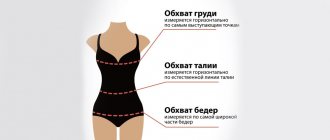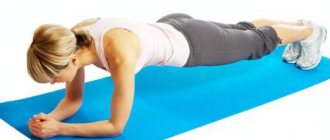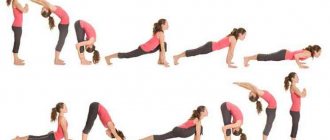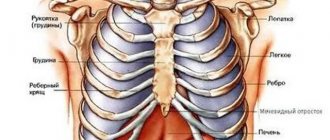Waist size in men: norm, table, measurement procedure, relationship with body weight
Waist size in men is not only an important indicator of how the figure develops and what is the state of health.
This is also one of the necessary measurements in choosing the right clothing size. Therefore, many people actively use size tables with waist measurements for men. When starting the process of losing weight, going on a diet, planning to order clothes, as well as doing exercises at home or in the gym, it is important to accurately and correctly measure the contours of the body. Why? When deciding to lose weight or build muscle, you need to know your starting point. For this purpose, tables with normal age and weight are used to measure waist size in men.
How to measure
This type of measurement is not difficult, but there are a few basic principles to keep in mind. First of all, correct body position is important.
The waist is slightly below the level of the ribs and just above the navel. When measuring yourself, it is better to do it in front of a mirror. A correctly taken measurement is obtained when measuring a centimeter around the narrowest part of the body. The centimeter is applied horizontally. In addition, during the measurement you should be in a standing position, you must first exhale. Moreover, you need to ensure that the centimeter does not fit too tightly or too loosely around the body. It is best to take measurements with an accuracy of 0.5 cm. Of course, measurements are never taken while wearing clothes; in order for the result to be accurate, you need a naked body. Measurements should not be taken immediately after a heavy meal. The results in this case will be erroneous.
After several months of struggling with excess pounds, after liters of sweat shed in the gym, sometimes you get the feeling that little has changed in your silhouette. Checking the waist size in men using a table approximately every 2 weeks allows you to understand whether the training is actually bringing results. The centimeter doesn't lie.
Measuring is a much more accurate tool for tracking progress than weighing yourself. Human body weight is constantly subject to small or large changes. This is influenced by the fact that we live under stress, sometimes we eat more than we need, we drink a lot, or, conversely, we suffer from dehydration, for example, during illness. Weight is constantly changing.
They examine the waist size of men for the clothing size they are going to select in the morning on an empty stomach, before the person eats or drinks anything. They do not measure clothing.
You need to stand with your feet hip-width apart, relax your body, including your gluteal muscles, and breathe calmly. You will need to straighten your back. It is important not to pull your stomach in too much.
When taking measurements, it is best to start at the top of the body and work your way down.
To compare waist size in men with the norm in the table, measurements are taken at the narrowest point of the torso. It is necessary to ensure that the person does not suck in his stomach. Waist circumference is measured approximately at the navel or slightly below.
Most people think that body weight is an indicator that determines the effectiveness of training or the degree of obesity. However, in reality, mass says little about the results of training. Body contour measurements are important; athletes recommend taking them every 1-2 weeks in the morning on an empty stomach. Based on their changes, the training program is adjusted, as well as the amount of calories in the diet. Or they select suitable clothes and sew new ones. Measurements of body contours should be performed in a standing position, slightly tensing the muscles, to avoid possible errors due to excessive relaxation of the body.
Let's start measuring
Some measurements are best taken with an assistant, but you can measure your waist circumference yourself. Stand up straight. You should not take measurements while sitting; the location of the muscles in a sitting position changes somewhat, and the measurements may be inaccurate. Take a measuring tape and place the zero mark on your belly button. If the waist is slightly higher or slightly lower, place the zero mark on a point located strictly below or above the navel. Place a tape measure around the narrowest circumference of the figure.
Make sure that the tape is positioned strictly parallel to the floor, does not twist, does not sag, but is not too tight
to measure weight
correctly to measure weight correctly
and also measure height, Solovyov index, waist size, hip size, determine body type and other important parameters for every person losing weight.
If you want to lose weight or simply control your weight, know that a lot depends on how correctly you measure your weight. As well as some other, besides weight, important anthropometric measurements.
To calculate the ideal weight and determine excess weight, we need to know not only our real, current weight, but also our exact height, sometimes age, waist size, hip size and body type.
For all these measurements we will need the following correctly adjusted and tested instruments: scales, usually floor scales (measurement range 20-160 kg) and a measuring tape. It's enough.
How to measure weight.
And now - in detail about how to correctly measure weight.
Weight measurement
(weighing) is carried out on floor scales. It is better to take electronic scales; the measurement error of the scales should be no more than +/-50 g. For any weight measurement and to determine the ideal weight, use the results of the same scales, then the calculations will be the most reliable.
To measure weight,
stand with your feet in the middle of the scale, without touching walls or adjacent objects, and do not move for 5-10 seconds. Wait until the numbers appear on the scale display - now you know your real, current weight.
Weight, unlike height, is a more variable indicator and can fluctuate even throughout the day depending on many factors. Daily weight fluctuations can be up to 1.5-2 kg.
To eliminate as much as possible possible average daily weight fluctuations, all weight measurements are taken in the first half of the day, exclusively BEFORE eating and drinking, on an empty stomach, and after visiting the toilet. It’s best to take it at the same time, before breakfast. You should be as undressed as possible - this is ideal, but underwear or light clothing in winter is quite acceptable.
Although you can gain weight in just 1 day - for example, immediately after a feast, step on the scales and see how many kilograms you have eaten. Unfortunately, when losing weight, it’s the other way around—stable weight loss can take hold only after 2-3 days.
How to measure your waist.
To measure your waist
, you need a flexible measuring tape, preferably made of a hard material that is not subject to stretching. It’s better not to take a cloth or oilcloth centimeter - there are “craftsmen” who can stretch the tape an extra 2-3 cm, or even more.
Correctly measure your waist - without clothes or in light underwear, so that the measurement is carried out on the skin.
Measure your waist at the narrowest point on your stomach. Unfortunately, if the excess weight is significant, then it can be difficult to measure the waist “by eye”; then the waist volume is measured in the middle between the edges of the costal arch and the crests of the iliac bones (the highest point of the pelvic bones).
To measure your waist, you need to stand straight, relax your stomach and let your arms hang freely along your body. The measuring tape itself must be positioned strictly horizontally, without tension.
The resulting dimensions are noted at the end of normal exhalation.
Try to measure correctly! Remember, be honest and careful when measuring your waist - this is a very important parameter for losing weight, here every centimeter is of great importance.
How to correctly measure thigh volume.
To determine your hip size, the measurement rules are the same as when measuring your waist.
I will briefly repeat: to determine the size of your hips, stand straight, heels together, buttocks and legs relaxed, arms at your sides.
Place the measuring tape strictly horizontally, without tension, around the hips at the level of the most protruding part of the buttocks and measure the hips. The volume of the hips should be measured without clothes.
How to measure height correctly
.
Since a person’s height gradually changes with age, one should measure one’s height every 5-10 years. If you use height data from 20 years ago to calculate excess weight, you may calculate incorrectly due to changes in height over this period. To avoid this, you need to correctly measure your height again before losing weight. To accurately measure your height, you need not an oilcloth meter, but a “construction meter” - with a rigid measuring tape made of hard metal that cannot stretch. You will also need an assistant. Correctly measure height in a room with room temperature: +18...+26 C. Measure height in the morning, because in the afternoon a person’s height may decrease due to the vertical position of the body and the load on the spine - the vertebrae are several " “sag” and by the evening the height value changes by 2-3 cm less than it was in the morning. And during sleep in a horizontal position, the muscles and ligaments of the spine relax and return to normal, so it is correct to measure height in the morning after sleep.
To measure your height, follow these steps:
Stand up straight with your back against a flat wall.
Legs are straightened, knees and heels are closed together. There should be no shoes on your feet; it is better to be barefoot or wear thin socks.
Place your arms along your body, shoulders back, back straight.
Raise your head parallel to the ground: so that the lower jaw is directed horizontally along the floor line, look straight ahead.
The heels, protruding parts of the buttocks, shoulder blades and the back of the head should touch the wall.
When you have taken the desired position, the assistant places a flat board or book on the top point of the head (crown), “squeezing” the hair - it can add 1-2 cm to the height value.
Then a pencil mark is placed on the wall against which your back is leaning, at the level of the bottom edge of the measuring board. Measure the distance from this mark to the floor level with a centimeter - and you will get your exact height.
How to determine your body type. Solovyov index.
To determine your ideal weight, in some cases you will need to know your body type (body type). This can be done “by eye”, but the correct way is to measure the Solovyov index and use it to determine your body type.
Solovyov index
- this is the diameter of your wrist in centimeters, it is determined by measuring the length of the wrist circumference on your working hand (usually on your right hand). Since the Solovyov index is an approximate indicator that allows you to judge the thickness of the bones of the skeleton, based on your Solovyov index value you can determine your
body type.
Conventionally, there are three types of figures:
1. Asthenic body type (“thin bone”).
External features of the figure: the longitudinal dimensions of the body prevail over the transverse ones: long and thin limbs, neck, chest, thin bones; relatively weak development of muscle tissue.
Rib angle: acute, that is, less than 90 degrees;
Solovyov index: for women = less than 15 cm, for men = less than 18 cm.
2. Normosthenic body type
External features of the figure: proportional build, average development of muscle tissue, all transverse dimensions are proportional to the longitudinal ones.
Rib angle: straight, that is, equal to 90 degrees;
Solovyov index: for women = 15-17, for men = 18-20 cm.
3. Hypersthenic body type (“wide bone”)
External features of the figure: the transverse dimensions of the body prevail over the longitudinal ones: short and powerful limbs, chest, neck, massive bones; relatively high development of muscle tissue.
Costal angle: obtuse, that is, more than 90 degrees;
Solovyov index: for women = more than 17 cm, for men = more than 20 centimeters.
Now we know how to correctly measure weight, as well as measure height, Solovyov index, waist and hips, and determine body type.
This means that we can now correctly determine:
Or simply calculate your body mass index.
Regular waist measurement helps an adult man monitor his health. According to medical data, an abdominal circumference of more than 102 cm (it is better for the waist to be less than 94 cm) reduces a man’s activity, can negatively affect the state of the cardiovascular system, increase stress levels and reduce the amount in the body.
Relationship with mass
To make it easier to figure out which direction to move, there is a norm table for men’s waist size. It takes into account the relationship of this indicator directly with body weight.
In order to compare a man’s waist size with the norm in the table, you only need a centimeter. But to determine the degree of obesity, you also need scales. The calculation is made as follows: body weight in kilograms is divided by height expressed in meters. However, there is a second method that uses waist measurements for men, the norm table.
It checks the ratio of waist circumference to hip circumference. You will need to measure your waist circumference (3-5 cm above the navel), as well as your hip circumference at the widest point. Then divide the waist circumference by the hip circumference. For example, a person with a waist circumference of 86 cm and a hip circumference of 96 cm has an index of 0.8.
This is how an indicator called WHR (Waist/Hip Ratio) is calculated. It expresses the ratio of waist circumference to hip circumference and determines body type and degree of obesity. If it is equal to/above 0.8 in women or equal to/above 1.0 in men, we are dealing with apple-type obesity, also called abdominal obesity. This is the most dangerous type of obesity, which is prone to the development of cardiovascular diseases and many other serious ailments. If the indicator value is less than 0.8 in women and 1.0 in men, we are talking about less serious obesity - pear-type obesity. But this does not mean that it does not increase health risks.
Determination of waist norm
So, the first thing to do is measure your waist circumference. It's important to do it right. The measurement is carried out with a regular centimeter tape. The girth for measurement is taken not at the level of the navel, but in the middle between the bottom line of the lower rib and the top point of the pelvic bone. Measurements are recorded as you exhale and taken twice. If the measurement values differ by 1 cm, the average result is taken.
What waist circumference should men have? Although an adjustment is made for body height, 102 cm, as noted earlier, is already a problem. We can say that the upper limit should be 94 cm. If a man’s waist exceeds 96 cm, then there is cause for concern. Then the person needs to take action to take control of the situation as soon as possible.
To understand in detail what waist size men should have, you need to consider the waist-height index. In short, this index is an indicator that characterizes a person’s physique. The body mass index, which is often used to check the correspondence of weight to height, does not reflect the situation with the physique as correctly as compared to the waist-height index.
The latter is based not on weight, but on waist circumference. Because weight characterizes not only the volume of fat, but consists of different components. This indicator, by the way, is used by athletes, including professional ones. Men actively involved in bodybuilding regularly check their waist size before and after training, as well as during the process.
What waist size should men have for a particular height? Using the waist/height ratio mentioned above, a guy will be able to determine whether his waist size is within the normal range. For this, in addition to a measuring tape, you will also need a calculator. Here you will have to deal with specific numbers.
The data obtained from the measurement in centimeters must be divided by the height in centimeters. The number that comes out as a result of division is the “waist-height” index. How to use these numbers? You can write down the following values for yourself, of course, they differ from the norms for women: the index norm for men is 0.43-0.53.
With an indicator of 0.54 and above, a man can be “diagnosed” as overweight and obese. An indicator of 0.58 means severe obesity. But you should not think that the lower these numbers, the better. For example, an indicator equal to or less than 0.42 may mean severe thinness. A value of 0.35 means pathological thinness and underweight in a man. Therefore, there is a lower limit for this indicator (0.42).
What does waist circumference mean?
Waist circumference itself is also an important indicator of health. The normal waist circumference for women is 80 cm; for men, 94 cm is considered normal. Values above 88 cm in women and 102 cm in men indicate the possibility of developing breathing problems, hypertension, high cholesterol, and the risk of developing diabetes and heart failure. It is also important to study the accumulation of subcutaneous fat.
How to determine the degree of obesity
Determining the degree of obesity in women and men is necessary to assess the severity of the disease. There are several methods for assessing the degree of obesity. Let's find out what methods and how they are used.
Due to our mentality and folk traditions, obesity (obesity) is still not considered a disease. And this is bad, because this condition can lead to more serious disorders in the body, such as impaired glucose tolerance or diabetes mellitus, at a minimum.
“What is the blood sugar level in prediabetes?”, read my article. Therefore, in the light of recent research, obesity has been identified as a separate nosological form in ICD 10, i.e. it is already an independent disease that needs to be treated.
To understand whether a patient is obese, various formulas are used to assess the degree of obesity.
Among the causes of excess weight, about 95% are exogenous-constitutional and nutritional obesity, in other words, these are people with a predisposition to weight gain and who do not monitor their diet. A person who has a genetic predisposition, but carefully monitors his diet and is actively involved in physical activity, rarely gains extra pounds.
The remaining 5% are obesity, as a symptom of some endocrine disease.
At the same time, in medicine there are 2 concepts:
- overweight
- actual obesity
We suggest you read: How to gain weight with hormonal drugs
The first could be called pre-obesity; it is not yet a disease, but later develops into obesity. The second is that obesity, as a separate disease, which has stages of development and which must be treated so that it does not develop into something more serious.
Subcutaneous fat examination
You need to relax your stomach, and then, at a close distance from the navel, pinch the skin between two fingers. If it has a thickness greater than 2.5 cm, this means that the accumulation of subcutaneous adipose tissue is excessive. It is necessary to get rid of it in the near future.
These simple measurements will indicate whether there is cause for concern and how urgent action needs to be taken to maintain health and well-being.
How often should you measure your waist?
It is recommended to examine this issue at least twice a week. When fat accumulates in the abdomen - on and around the internal organs - fat cells release chemicals that cause inflammation and produce proteins associated with appetite. In addition, insulin resistance increases and the likelihood of metabolic disorders increases as inflammation affects muscle and liver cells. Their functions may be inhibited. Meanwhile, the natural appetite regulation system does not work properly, leading to overeating and increased belly fat.
Measuring your waist with a tape measure is a good indicator of the amount of belly fat.
Why do you need to monitor your waist size?
Excess weight is becoming a serious problem for modern society. Weight gain in the extremities (buttocks, hips, shoulders) is not as dangerous as an increase in waist size. The reason for this lies in the anatomy of the human body: excess folds in the abdominal area and above indicate visceral fat. This is when the internal organs of the abdominal cavity begin to become covered with fat.
And this entails a number of negative consequences:
- natural blood circulation and lymphatic drainage are disrupted, which leads to cardiovascular diseases;
- liver function worsens;
- the risk of developing diabetes mellitus increases by 2 times;
- hormonal levels are distorted (the production of the male hormone, testosterone, increases);
- the attractiveness and generally accepted proportions of the figure are lost.
With each passing decade, a person physiologically gains weight. This is the norm and is explained by hormonal and physicochemical changes in the body. The main thing is to monitor your waist size.
Body weight can and should change, but the ratio of the main parameters (waist volume to height or hip circumference) must be maintained.
How to reduce your waist
Reducing belly fat is more difficult than simply losing weight. Often, a man’s weight remains normal, but his waist size significantly exceeds acceptable values. It is possible to remove extra centimeters if you follow the following rules:
- There is no need to go on a strict diet and go on fasting days . This usually backfires. When cells suddenly stop receiving nutrition, they begin to accumulate fat and gain weight. It is better to reduce your diet by about 300 kilocalories. It is useful to change your diet, eat little but often. You need to stop eating foods rich in carbohydrates and animal fats, while vegetable fats can be consumed without restrictions. Separate meals can also be beneficial. This diet will lead to a decrease in the number and volume of fat cells.
- While working out in the gym, you need to pay attention to your abdominal muscles . Exercise forces the body to produce more testosterone, this hormone fights visceral fat deposits. But at the same time, you must eat right, otherwise the fat deposits will not disappear, but will remain under a layer of muscle. It is useful to engage in sports that develop breathing: swimming, martial arts, running, fast walking.
- You need to fight constipation and bloating . This can also cause an increase in waist size. Processed food that lingers in the intestines begins to rot, which causes the formation of gases. You need to regularly do yoga exercises with wave-like movements of the abdomen, thus massaging the internal organs.
How to measure your waist circumference correctly
Measuring your waist is very easy.
To do this, there are a number of sequential actions:
- First you need to expose your stomach by taking off your T-shirt or jacket. If your trousers are in the way, lower them.
- The waist is the narrowest part of the body. With your hands you need to feel for the beginning of the chest. For convenience, it is better to stand in front of a mirror to visually observe the process. Approximate orientation - level slightly above the navel.
- Take a measuring tape and, holding one end just above the navel level, wrap it around your torso. Bring out end 2 and connect to 1.
- Exhale. Make sure the tape is not twisted or stretched.
- View the value on the tape. The number on the 2nd end of the tape is your waist circumference.
- To ensure accurate measurements, repeat the entire sequence again.
Measuring the hips
Accurate hip measurements are important for tailoring. To measure your hips, remove your outer clothing, place your feet together, take a measuring tape, and wrap it around your hips at the widest part. The point where the tape will intersect with its beginning will be the volume of your hips.
Detailed instructions on how to measure your hips:
Find a full-length mirror
. Although it is easier to measure your hips yourself than other parts of the body, a mirror will help you make sure that the measuring tape is not twisted. But even without a mirror everything will work out.
Take off your clothes.
Take off your outerwear: trousers, skirt, dress, etc. Because no matter how thin it is, it will add extra volume to you. We leave the linen, because... we always wear it.
Put your feet together
. Standing with your legs apart will not give you an accurate result. The maximum can be placed at shoulder width, but it is better together.
Hips not waist
. It sounds stupid, but sometimes people confuse these concepts. The waist is the narrowest part of your body from your shoulders to your butt. The hips are the widest part below the waist.
Looking for the widest place
. To obtain the volume of the hips, we are looking for their widest part. For a perfect fit of future clothing, it is very important to find the widest part. To do this, we use a measuring tape, placing it lower or higher by a centimeter until you find the desired point.
Take a measuring tape
.
Hold one end of the tape on one hip. It doesn't matter which side you start from. You can also pull it closer to the middle if that makes it easier for you. Wrap the tape around your hips
. Just make sure the tape doesn't twist.
Look in the mirror
. Make sure the tape is level and parallel to the floor.
Press the tape against your body.
The tape should not dig into the skin or dangle loosely. You can use your finger as a tension gauge. Only one finger should be placed between the body and the tape.
We get the result.
We use a mirror to see the result while the tape is on the hips, or we press our fingers where the tape intersects with its beginning. We record the measurements. Now we know the volume of the hips. But for sewing clothes we will need other parameters, for example, hip circumference. Like volume, hip circumference is measured at the widest part of the leg.
- Like your hips, you measure your thigh at the thickest part of your leg.
- The inseam length of the trousers is determined along the inside of the leg from the crotch to the place where the trousers should end. If you already have trousers of a suitable length, you can determine the length of the inseam using them.
Add a few centimeters when sewing. When you sew clothes, you should not use the measurements taken as is, as the clothes should not be too tight, otherwise it will be difficult for you to move. Therefore, to make clothes comfortable, you should add a couple of centimeters to your measurements.
- It is necessary to slightly increase the value of the measurements for two reasons. The first and already mentioned is that the clothes are comfortable. And the second is that an increase in measurements may be required to create a new clothing design. For example, you want to sew a full, flowing skirt, and then you will need to increase the hip measurement much more than when sewing an a-line skirt.
- The elasticity of the fabric used for sewing also affects the allowance used. If the fabric stretches very well, then you probably don't need to add much more.
- Most ready-made patterns will have instructions that tell you how many extra inches you should add to your measurements to determine the size you need. However, if you are making a pattern yourself, then it would be better for you to add 5-10 cm to the volume of your hips (depending on how tight you want the clothes to be).
- If you are a plus-size person, then to provide additional freedom of movement, you can further increase your hip measurement. Remember, when buying fabric, look at its composition, if possible, touch it in person. If it contains elastane or other additives that give it a stretch effect, this must be taken into account when sewing.
Remember, when buying fabric, look at its composition, if possible, touch it in person. If it contains elastane or other additives that give it a stretch effect, this must be taken into account when sewing.
A thin wasp waist is the dream of many women. And it’s not just about the aesthetic component, which is undoubtedly important. It turns out that waist circumference is an important indicator that you need to know not only when choosing clothes. It is also an important marker that can communicate health among both women and men. So if, after reading the article and taking measurements, it turns out that the indicators leave much to be desired, this is a reason to think about your health, play sports and reconsider your diet.
Waist circumference norms for women of different ages
There are several types of female figures:
- pear;
- apple;
- hourglass;
- triangle;
- rectangle.
The genetic factor is one of the determining factors here. Therefore, waist size in women of the same age can vary over a fairly wide range. Sometimes a girl at 25 years old can have a greater girth than a woman at 35. And this is also a variant of the norm in the absence of other violations.
However, there is a permissible value, exceeding which is unacceptable for any age. A woman's waist, more than 80 cm, signals the beginning of problems. This figure is easy to remember and control this parameter. For men, this norm is 92 cm.
Waist circumference standards, depending on height and weight
Waist size in women (the norm is up to 80 cm) is directly proportional to height and weight. There are several methods using which you can calculate your parameters and see if they fit within acceptable standards. The most popular of them says: if you subtract the number 100 from your height, you should get the ideal waist size.
It’s the same with weight: subtract 100 from height and get weight.
It becomes clear that the ideal ratio of all parameters comes down to equal numerical values of the waist circumference and the woman’s weight. These are too average standards, and for many they are not suitable even if there are no deviations. But there is a category of women of average height whose proportions fit into the results of these formulas.
Their height ranges from 165 to 175 cm. Waist size in cm is approximately equal to weight in kg. It is also true for them that losing weight by 1 kg results in a reduction in waist circumference by 1 cm.
MEASUREMENT PROCESS
To take the measurement, you only need a measuring tape, which must be soft. It is better if the tailor's centimeter also has a measurement in inches. This will help you know the size when ordering a dress from abroad. There is also a centimeter with locking loops and hooks. In the absence of a special measuring tape, you can measure with an ordinary cord or ribbon. After measuring your waist circumference, you can simply find out the length of the cord using a ruler.
Waist measurement should be carried out on a naked body, without underwear. This is especially true if you plan to buy clothes that are very tight to the body. The presence of clothing distorts the actual size. To correctly measure this part of the body, you should remove your shoes, especially those with high heels. Heels affect posture and distort body parameters. The accuracy of the measurement result depends on the position of the body. You need to stand up straight, relax your body, and exhale slightly. If the abdomen is pulled in too much, the measurement will be incorrect.
When measuring correctly, the skin at the waist should not be squeezed, but a loosely dangling measuring tape will also not give the correct result. A good method of determining is to stick a couple of fingers between the waist and the band. If they do not pass, then the tape should be loosened a little, no matter how much you would like to see fewer centimeters. The correct value will be where the mark coincides with zero. To correctly measure the girth of the narrowest part of the body, the tape must lie strictly horizontally.
There is an opinion, gleaned from fashion designers, that the waist should be measured along the navel line. But this rule is only suitable for a wasp waist and the location of the navel exactly between the edge of the lower ribs and the pelvic bones. But every woman is different, and the location of the navel may be slightly different. Therefore, the surest way is to measure at the narrowest point of the waist region. The waist in women may not be clearly defined or, conversely, very noticeable:
- The waist stands out well in women with an hourglass or pear-shaped figure;
- if the body type is “rectangle”, “triangle”, “apple”, then the waist is almost invisible, which causes some difficulties with correctly finding the narrowest point.
Many men often have no waist, and also have a belly. In this case, the tape is located three centimeters above the femur. In the front part, the tape should pass along the extreme point. This measurement is necessary when selecting a jacket. To buy trousers, you need to measure along the belt line.
Waist-to-hip ratio, an indicator of attractiveness and health
Waist size in women (the norm depends not only on height and weight) can change over time. But the correct proportions must be maintained, one of which is the ratio of waist to hip circumference (STB). For women it should be no more than 0.7. The global average today is almost 0.8. This suggests that more and more women are becoming obese.
A waist-to-hip ratio of more than 0.85 in women always means a diagnosis of visceral obesity, for which you should immediately consult a general practitioner and begin a full examination. An increase in waist circumference leads to irreversible internal processes that can lead to heart attacks, strokes or cancer.
The first step to take is to start eating healthy. Disturbed proportions of the waist and hip circumference can be explained by a genetic factor, but the percentage of such cases is very small.
Most of the facts of visceral weight gain are caused by improper and excessive nutrition, as well as a sedentary lifestyle.
In addition to health indicators, the ratio of waist and hip circumference determines the attractiveness of a woman and the harmony of her shapes and sizes. According to studies, men subconsciously choose women with an STB indicator of 0.6 - 0.7. In this case, an impressive hip girth is very important, symbolizing the ability to bear children.
VISCERAL OBESITY
To determine the presence of abdominal-visceral obesity, you need to measure your waist and hip circumference. A waist circumference of more than 94 centimeters is a danger signal. Armed with a tailor's measuring tape, you should measure your waist a couple of centimeters above the navel. Hip circumference should be measured at its widest part. If the ratio of these values is 1.0 or more, then you should be concerned about your health. With a value of 0.9, the man is normal, has good potency and has virtually no risk of developing prostate cancer.
You can do without calculating body parameters; you just need to stand up straight, squeeze a fold of belly fat between your fingers and measure. A size greater than two centimeters makes you wary and requires you to start taking action to reduce weight.
The shape of the abdomen in men varies:
- loose, shapeless, fat accumulations under the skin;
- hard, ball-like;
- egg-shaped, so-called beer belly. In fact, this is visceral obesity, the most dangerous to health.
Abdominal obesity is typical mainly for men. It is characterized by the deposition of fat around internal organs. This indicates an increase in metabolic disorders. Subsequently, the visceral type of obesity leads to the development of glucose tolerance and the threat of diabetes mellitus. There is an increase in the proportion of cholesterol, leading to the development of atherosclerosis and heart disease. This type of obesity becomes most relevant for men during the period of decreased testosterone production, which occurs after thirty years.
Ways to correct waist size
Waist size for women is an indicator that needs to be monitored and maintained. After detecting an excess of the norm, it is not recommended to immediately start losing weight.
A consultation with a general practitioner is required, who, based on the results of prescribed tests, may allow you to start training or other methods of reducing your waist. Only if there are no contraindications can we begin to solve the problem.
Physical activities
There is a whole range of special exercises aimed at correcting the waist at home:
- Hand touching heels. Lie down in the starting position on the mat. Bend your knees. With your straightened arm, reach your heel with your fingertips (right hand to right leg). Perform twisting by tensing the oblique abdominal muscles. Returning to the starting position, you need to change your hand, without lowering your head. Do 3 sets of 10 times on each side.
- Plank with leg pull-up . Get into the starting plank position: stand on your elbows and toes with a straight torso without bending. Tightening your abdominal muscles, pull your leg toward your elbow (right to right). Return to plank and change legs. Repeat 3 sets of 15 crunches.
- Twisting with a load . For the starting position, you need to sit on the floor and bend your knees. Take a weight in your hands (a dumbbell, a thick book, a bottle of water) and hold it at chest level. Lift your feet off the floor. Using twisting movements, lower the load to the right and left alternately, wrapping it around your waist. The legs are held in place by the abdominal muscles and do not touch the surface. Perform 3 sets of 20 repetitions.
- Lowering straight legs from a lying position . Lie on the floor, stretch your arms perpendicular to the axis of your body. Straighten your legs and connect your heels, raise them until an angle of 90 0 is formed with the surface. Lower your legs alternately to the right and left without touching the floor. At the same time, the lower back is pressed and retracted, and the oblique abdominal muscles work. Do 3 sets of 10 times in each direction.
- Exercise "Bicycle" . Lie on the floor, bend your knees. Place your hands behind your head, elbows parallel to the floor. Tightening your abdominal muscles and lifting 1 arm and 1 leg, tear off the body. In this case, the elbow reaches towards the opposite knee. When returning to the starting position, it is important not to lower your arms and legs to the floor. Do 3 sets of 15 repetitions.
- Side plank. Lie on your side, support yourself on your elbow. Place the basin on the floor. The second hand is on the belt. Raise your pelvis and lift your body off the surface. The body should represent a straight line. Stay in this position for 15 seconds. Then relax and lower your pelvis. Do 10 times and change sides. It is necessary to perform 2 approaches.
- Bend over with a load . Stand straight in the starting position: feet shoulder-width apart, pelvis twisted up, arms placed freely along the body. Take a load (dumbbell) in your hands. By twisting at the waist, lower yourself alternately to the left and right sides. In this case, the dumbbells are pulled down, creating resistance. Repeat 3 sets of 20 times.
- Raising arms and legs on all fours . Starting position - stand on your knees and hands. The pelvis needs to be twisted up, the stomach should be pulled in, and the lower back should not be bent. Alternately lift the opposite arm and leg, extending them parallel to the floor. It is important to do the exercise slowly, tensing your abs and feeling your balance. Repeat 3 sets of 15 times.
- Raising arms and legs from a lying position . Lie on the floor on your stomach, stretch your arms and legs as far as possible and relax. Straining your torso, raise your opposite arm and leg. Stay in this position for a few seconds. At the same time, the head does not fall back, the neck is relaxed. Do 2 sets of 10 reps.
- Pelvic descent . The starting position is to kneel. Stretch your arms high up. Twisting at the waist, lower the pelvis either to the left or to the right. In this case, the buttocks should touch the floor. Complete 3 sets of 20 repetitions.
It is important to perform the listed exercises 2 hours after meals every day.
Wraps
Body wrap is one of the widely used means for losing weight, which can be done either in a beauty salon or at home. The essence is to apply a special product to the entire body and then wrap it in film, resulting in the outflow of excess fluid from the body. Therefore, the effect of the procedure is noticeable after just 1 time.
OTHER CAUSES OF FULL WAIST
When a man reaches forty years of age, sex hormones are produced in smaller quantities. Testosterone is not only responsible for sexual desire, it controls the activity of most organs. Thanks to him, a man has an active metabolism, that is, metabolism. Therefore, a sufficient amount of this hormone guarantees the absence of obesity. A decrease in testosterone causes a corresponding increase in estrogen. This is how excess abdominal fat appears, due to which the male hormone turns into a female one. At the same time, the hormone leptin is formed, which suppresses the formation of testosterone in the testicles.
Sometimes the cause of obesity is simple stress. Mental overload leads to a change in the balance of hormones to suppress a critical reaction to the situation, resulting in the storage of large amounts of fat. Often a man begins to overeat to get rid of negative emotions, because delicious food gives pleasure and relaxes a person. At the same time, there is no real hunger. With age, body weight also increases for most men. This is due to a slowdown in metabolism and cessation of previous activity. Quitting cigarettes provokes eating sweets as compensation. In addition, when the body undergoes restructuring due to the lack of nicotine, metabolic disruptions occur.
The problem of a fat belly in men is not only an unsightly aesthetic appearance. The matter is much more serious and concerns the duration and quality of his life. An imperceptible increase in centimeters in the waist area is real years of life that disappear under layers of fat.
What can your waist circumference tell you?
Among the many methods that detect the presence of extra pounds in a person, the most popular is the calculation of body mass index. But scientists and doctors, when studying health status, more often consider such an indicator as waist circumference. This is because BMI does not indicate the distribution of fat in the body. But it is this factor that influences the risk of developing personal diseases.
Belt sizes, what to pay attention to
Statistics show that men's waist measurements should be approximately half of their total height. For example, if an index ratio of 0.53 is observed according to measurements, it means that there are already excess fat deposits in the body, with which something needs to be done immediately. Analyzing the general indicators of how many centimeters the waist should be for women and men, it is necessary to note the following indicators:
- If the waist size is set with a coefficient of up to 0.50 of the height, this is a normal condition, which means that the amount of fat in the body is minimal, therefore, there is no need to make any additional attempts to lose it;
- With a coefficient of 0.53, you need to think about revising your own diet; these are the first signs that there are all the prerequisites for subsequent obesity;
- In turn, an indicator of 0.58 centimeters already indicates the fact that this is the first stage of obesity, therefore, if the waist has reached the level of this indicator in its values, it means that mortality increases by about 50%, and this must be avoided by any possible means .
We can summarize this by establishing that the optimal value is a waist circumference of up to 94 centimeters. A subsequent increase to 102 centimeters already directly indicates the presence of dangerous fat deposits, and if this value is exceeded, it means that the first signs of obesity are noticeable and it is necessary to take concrete steps in order to solve this problem and prevent your body from taking such a big risk. Consequently, the more the indicator increases, the more dangerous it will be for a person to live. Even when your overall weight remains normal, a large belly will become a real problem that will be very difficult to solve.
Such manifestations can easily indicate that the risk of the formation of cancer cells and heart disorders is high, due to which virtually the entire man’s body suffers. It is worth noting the fact that from excess fat in the abdominal area, not only the body as a whole, but also the skeleton will suffer in many ways; it will be subject to additional stress and this can lead to very serious consequences. At the same time, there is a significant decrease in male strength indicators, which will need immediate attention so as not to cause complications in relationships with women.
How to correctly measure waist circumference: WHO instructions
According to the World Health Organization (WHO) protocol, waist circumference is measured in the area between the lower edge of the lowest rib and the top point of the pelvic bone - the iliac crest. For measurements, a regular measuring tape is required. When girthed, the “centimeter” should create a pressure that is equivalent to 100 grams. Using the same tool, the hip circumference is determined by wrapping the tape around the widest part of the buttocks.
A mistake when measuring the waist is fixing the measuring tape at the level of the navel. Numerous studies have shown that this method does not give entirely correct results: the waist may turn out thinner than it actually is.
Measuring the circumference of both parts of the body requires the correct position of the person. You need to take off excess clothes, stand up straight, put your feet together, and put your arms to the sides. Breathing should be calm. All measurements are recorded during exhalation and repeated twice. If the difference in measurements is one centimeter, then the average results are taken.
Waist circumference norms for men and women
In accordance with the recommendations of the World Health Organization, doctors distinguish three main categories of waist circumference (WC) indicators.
With normal body weight, the waist circumference for men should be less than 94 cm, and for women less than 80 cm.
Overweight is indicated by a WC measuring more than 94 cm and less than 101.9 cm in men, and from 80 to 87.9 cm in women.
A sign of abdominal obesity is a waist circumference of more than 102 cm in men and more than 88 cm in women.
It should be noted that with age, waist circumference increases. Moreover, this depends on the person’s height: the taller the person, the greater the increase in his waist. However, this phenomenon occurs up to 85 years of age. In people aged 85 to 89 years, the average waist circumference decreases.
Waist-to-hip ratio: an indicator of attractiveness and health
Waist-to-hip ratio refers to the ratio of your waist circumference to your hip circumference. This indicator is quite popular in the West, where scientists have conducted a lot of research trying to find out how it affects a person’s attractiveness and his overall health. In English it is denoted by the abbreviation WHR (waist-to-hip ratio), in Russian - STB.
The waist-to-hip ratio allows you not only to determine how ideal a man or woman’s figure is, but also to predict the state of health for the future. Scientific research shows that women with an apple-shaped body type (that is, when the waist is wider than the hips) are more likely to develop health problems than those with a pear-shaped body (that is, when the hips are wider than the waist). This ratio is also used to determine central obesity, which contributes to the occurrence of other more serious diseases.
So, the following ratios are considered the norm:
- Waist circumference / Hip circumference
MEN'S WAIST PARAMETERS
People who have a normal height-to-weight ratio, but have excess volume in the waist area, are at risk.
Most often, men refer to a hereditary factor. Genetics can explain the waist-to-hip ratio in only 22–50% of cases. In other examples, the influence of lifestyle and nutrition was felt. The normal circumference of the waist area should not be more than half the height. The ratio of waist and height parameters with the resulting index of 0.53 already indicates the presence of excess deposits. An index of 0.58 signals the onset of obesity. If the waist has reached a volume of one hundred centimeters or more, then the mortality rate becomes 50% higher. The norm is a waist circumference of up to 94 centimeters. A further increase in body fat, expanding the waist to 102 centimeters, is already an excess of body weight. An even greater value of this value is already considered a disease and is called obesity.
Relationships that make women attractive
Even in ancient times, ideal women were imagined with TBS fluctuating in the range of 0.6-0.7. In other words, the wider a woman's hips were in relation to her waist, the more beautiful she was considered. Most likely, such preferences of representatives of the stronger sex are explained by their subconscious understanding that the chosen one with such forms is more predisposed to procreation.
Modern research has shown that today the waist-to-hip ratio continues to be an important parameter of female attractiveness for men. Thus, women with a TBC equal to 0.7 are rated by the stronger sex from Indo-European cultures as more attractive. Tastes may vary depending on the ethnicity of men. In this case, the ideal waist-to-hip ratio for women ranges from 0.6 (in South America, parts of Africa, China) to 0.8 (in Tanzania and Cameroon).











